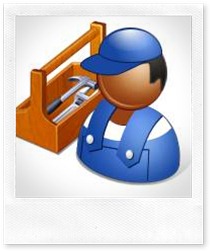Entries Tagged 'copywriting tips' ↓
August 4th, 2010 — copywriting tips, email marketing, freelance copywriter, marketing, twitter
 Email marketing has been a revolution for many businesses.
Email marketing has been a revolution for many businesses.
It has given them an opportunity to market to thousands of people simultaneously and in a very cost effective way. Not only that, but it is also measurable – you can see who’s opened your email, what they did after they read it etc.
But, as a copywriter, one of the hardest aspects of email marketing is coming up with a subject line that makes people want to open the email. It is the do or die. If you can’t get people to open it, you not going to sell them anything.
Creating subject lines takes a lot of work and in my previous post 10 Words That Will Make People Open Your Email I shared with you some powerful words that would help boost your open rate.
But the best way to determine the effectiveness of any subject line it to test it. Split testing is often used – send one group an email with one subject line, and then send another group the same email but with a different subject line. But how about using social media to test their effectiveness?
This, I will admit, was something I’d never actually thought of until I read a post on BlueSkyFactory’s blog. In How to use social media to boost email marketing open rate, Christopher Penn describes how he used Twitter to help determine the effectiveness of an email subject line.
If your Twitter following resembles the demographics of your email marketing list, why not try it out?
If you do, bookmark this post and come back and tell me how you got on.
August 2nd, 2010 — copywriter, copywriting tips, freelance copywriter, proofreading
 Like most people I’ve always dreamed of being a writer. When I was at school I had a pink hard back note book I used to write stories in. I used to think they were the best thing since sliced bread but I wouldn’t let anyone else read them; they were mine, something I had created and were for no one else but me.
Like most people I’ve always dreamed of being a writer. When I was at school I had a pink hard back note book I used to write stories in. I used to think they were the best thing since sliced bread but I wouldn’t let anyone else read them; they were mine, something I had created and were for no one else but me.
I found that little pink book a few months ago and had a read. Boy am I glad I never showed them to anyone else! The sad thing was I thought they were good. They weren’t.
I’ve not given up on the writing dream and have written a novel and a half in my adult years (not published) – after the pink book scenario I’m even more wary of my writing. Mind you, in a funny way I have ended up earning a living through writing – being a freelance copywriter wasn’t exactly how I’d envisaged it but I love it. Watch out J.K. Rowling – one day…
The pink book taught me a good lesson about reviewing my work. During the writing process you become completely absorbed in what you are doing. You are so close you can’t see beyond the words you’ve written which makes reviewing it very difficult. But, over time (as with the pink book), your perception of your work changes making it easier to be more critical.
But, as a commercial writer, time is usually of the essence. You don’t often have the luxury of being able to put your work away for a few months (or longer) before reviewing it. So performing an effective critique on your own work is difficult.
To help you, I’ve put together five tips to review your work effectively which I’ve used over the years.
1. Leave it
As I said earlier, this one isn’t easy. Because of tight deadlines you won’t have the luxury of leaving your work for a long period. However I normally find that by working on several projects simulatneously, I can complete one task, leave it for 24/48 hours and then review it.
That is normally enough time (especially if I’m working on a number of things) for me to come back to it with fresh eyes.
2. Get someone else to read it
This one is going to depend on how you work. I work alone so it’s a bit difficult to get someone else to read things for me (although my husband has been known to be dragged in to read things for me). But if you can get a second opionion, that will help enormously.
3. Read it like a reader
This one takes practice. Even though you’ve taken the time to research and get to know your client’s business intimately to write about it, you now have to look at your copy as a reader would; someone without any prior knowledge of the product or company. Look out for sections that are irrelevant. Does it get to the meaty benefits quickly enough to keep your interest? Does it answer your questions? Does it tell you what to do next?
4. Read out loud
Number 3 will help you determine the effectiveness of your writing, this one will help ensure your English is correct and that it flows. I always feel a right Charlie sat in my office reading my work aloud, but it really works. Only when you can hear it with intonation, can you really asses its rhythm and voice. If you stumble over sections, re-write them until they flow easily.
5. Proofread
This is the last thing I do. Thorough proofreading is essential. The quality of your writing will speak volumes about you so you must make sure it’s perfect. I don’t know about you, but I find reading off a screen really difficult so I always try and proofread from a hardcopy. Plus reading backwards is a great way to find mistakes. Frequently, when you read something you’ve written, your mind will play tricks on you filling in missing words because you know they should be there or skimming typos. If you read your work backwards, yes it will take longer, but it will also force you to read every word making it much easier to find mistakes – try it, it works.
How do you review your work? Are there any tips you’d like to share? If so please leave a comment, I’d love to hear them.
July 30th, 2010 — conversion, copywriter, copywriting tips, freelance copywriter, website copywriting
 First off, when I say “The Importance of Telling Your Reader What to Do” I don’t mean that your copywriting should become prescriptive and demanding. That would just be silly. After all, a copywriter is supposed to build rapport with her readers; she’s supposed to get to know them, work out what makes them tick. She’s not supposed to shout at them and give them orders.
First off, when I say “The Importance of Telling Your Reader What to Do” I don’t mean that your copywriting should become prescriptive and demanding. That would just be silly. After all, a copywriter is supposed to build rapport with her readers; she’s supposed to get to know them, work out what makes them tick. She’s not supposed to shout at them and give them orders.
Or is she?
Softly at first
If you want your copy to work, you’ve got to build a realtionship with your reader. You must immediately show them that you understand what they are looking for. By telling them how your product/service will benefit them will show them that you care, you are willing to listen, and you’ll make their life better.
Aren’t you great?
By the time they’ve finished reading the inital paragraphs of your website they’ll be your best friend hanging on your every word.
Then what?
Well, now’s the time to build on your new found friendship. By now your reader trusts you and is ready to be lead by you to the next stage of the relationship.
But there’s a problem. You’ve told them how you’re going to improve their life. They love your product/service and realise that it is exactly what they’ve been looking for. But now, after doing all the hard work and convincing them they need it, you’ve left them high and dry.
They’ve read to the end of the page, ready to do whatever you ask, but there’s nothing. Zero. A big fat zilch. Just empty space.
Now they’re confused. They panic and hit the back browser and go to another website in the hope that will tell them what to do next.
So what did you forget?
You forgot one of the most important sections of your copywriting. It may only be a few words, but they could be the most important few words on the entire web page.
What’s the point in creating superb copy that has convinced your reader to buy if you forget the call to action?
“But they know they want to buy the product, why should I have to tell them to buy it?”
A very valid point, but if you don’t have a line at the bottom of your page that says Click here to buy now, or perhaps Call us today on 123 456 78 and book your appoinment, your reader won’t know what to do. Why should they go hunting round your website trying to work out what to do next if you can’t be bothered to tell them.
It might sound laughable that people forget to add a CTA but it happens all the time. I’ve lost count of the nimber of websites I’ve seen without one leaving the owner wondering why their conversion rate is so low.
Go and take a look at your website now – do you have a CTA? If the answer’s “no”, before you do anything else today add one to every sales page. Don’t leave anything to chance, if you want your reader to buy, tell them.
July 5th, 2010 — copywriter, copywriting tips, internet marketing, search engine optimisation
 The internet is taking over – hardly breaking news, but it is if you are a business owner. More and more people are searching for local companies through the search engines so it’s never been more important to ensure you have a strong local SEO presence on the web.
The internet is taking over – hardly breaking news, but it is if you are a business owner. More and more people are searching for local companies through the search engines so it’s never been more important to ensure you have a strong local SEO presence on the web.
Many company websites concentrate on their products and services and omit their geographical details that will help them get found by consumers. With the advent of increased and improved mobile search, it is vital you stand out in your local area. And the best way to do that is by utilising the power of local search.
Location, location, location
If your company covers a specific geographical location, make sure those details are added to your HTML through page titles. You should also try and use these details within your copy and headings. But ensure you are sensible about it. Remember you are first and foremost writing for your reader – if you over do it, the page will look clumsy. Other areas for location information are within the footer along with your address and also within your internal hypertext linking structure. Instead of linking freelance copywriter, use a geographical reference such as Suffolk freelance copywriter.
YouTube
As well as optimising your website for local search terms, you can boost your presence by using video marketing. Upload your video to YouTube and then use very localised tags – without being spammy. The chances are (depending on the competitiveness of your keywords) you’ll be able to get these ranked and the more entries you can get on a front page local search results, the fewer your competitors can have.
Wider areas
Many buisnesses will serve multiple geographical areas. If this is the case, you should consider creating specific landing pages for each area. They should have unique content (you don’t want to fall foul of the duplicate content trap) and should be optimised for each specific area. Hypertext links within these pages can then drive your visitors to your main website.
Boost your profile
Social networking sites make it easy to spread your name and your business name to a wide audience. Set up social media profiles, again relating to your geographical region. But, as with the landing page content, make sure each description is different. You should also utilise Google Places, Yahoo local, and Bing Local to boost your local profile.
So the name of the game is local search – when creating your website always keep in mind your main business location and use it to its full potential.
June 2nd, 2010 — blogging, copywriter, copywriting tips, internet marketing

So you’re a blogger.
You may have been blogging for a while, or you may have just started out. Whether you are blogging for business or for pleasure, maintaining your blog is essential if you are to keep and build on your number of readers.
There are three main factors that can determine the success of your blog:
- The subject of your blog
- How your blog looks (it’s aesthetic layout)
- How you promote your blog
If you write about an obscure subject, you will limit your audience. But if you are writing about specific topic – for example, I use this blog to mainly talk about copywriting – try and stick to that area. For me, I write about being a copywriter, copywriting tips, marketing suggestions, social media and search engine optimisation. Basically, all these areas interrelate and so add value to my readers (I hope).
The look of your blog is also very important. Many people like things clean and simple. Over use of adverts and flashy images can be very off putting, so give careful consideration about how you want your blog to look.
Finally, don’t make the mistake of thinking that if you post articles they will automatically get read. You have to promote your blog so people know it’s there – list it in blog directories, utilise the power of SEO, and use social media to spread the word.
How to maintain your blog
- The main key to maintaining your blog is to post regularly. As your readership grows, they will become used to you posting regularly. If they know you are going to generate regular, great content it will give them an incentive to return.
- Blogging is also about building a relationship with your readers. Over time they get to recognise your voice. When they come to your blog it will be like popping in to see an old friend. That type of bond can be very powerful and will retain readers.
- You also have to understand your audience. The best way to attract a wide readership is by concentrating on a niche. As I mentioned earlier, mine is on all things copywriting and marketing. My readers know that each post will give them some new information about this topic. By focusing on a specific area, your readers will come to see you as an authority in that field.
- Nothing ever stays the same forever, but if you want to make changes to the look and feel of your blog, make only small ones at a time. To your readers, your blog is like a comfortable pair of slippers. They know what they’ll get when they visit it. If you give it a major overhaul, it can be a shock. People don’t like change – so if you do want to revamp, just do a bit at a time and monitor each change to see what effect it has had.
Remember – post regularly, write for your audience, only make small changes at a time – follow those simple rules and you and your readers will enjoy a mutual blogging relationship for a long time to come.
 Email marketing has been a revolution for many businesses.
Email marketing has been a revolution for many businesses. Like most people I’ve always dreamed of being a writer. When I was at school I had a pink hard back note book I used to write stories in. I used to think they were the best thing since sliced bread but I wouldn’t let anyone else read them; they were mine, something I had created and were for no one else but me.
Like most people I’ve always dreamed of being a writer. When I was at school I had a pink hard back note book I used to write stories in. I used to think they were the best thing since sliced bread but I wouldn’t let anyone else read them; they were mine, something I had created and were for no one else but me. First off, when I say “The Importance of Telling Your Reader What to Do” I don’t mean that your copywriting should become prescriptive and demanding. That would just be silly. After all, a
First off, when I say “The Importance of Telling Your Reader What to Do” I don’t mean that your copywriting should become prescriptive and demanding. That would just be silly. After all, a  The internet is taking over – hardly breaking news, but it is if you are a business owner. More and more people are searching for local companies through the search engines so it’s never been more important to ensure you have a strong local SEO presence on the web.
The internet is taking over – hardly breaking news, but it is if you are a business owner. More and more people are searching for local companies through the search engines so it’s never been more important to ensure you have a strong local SEO presence on the web.





